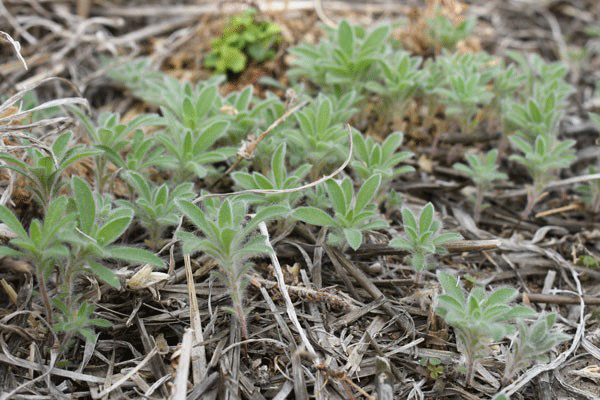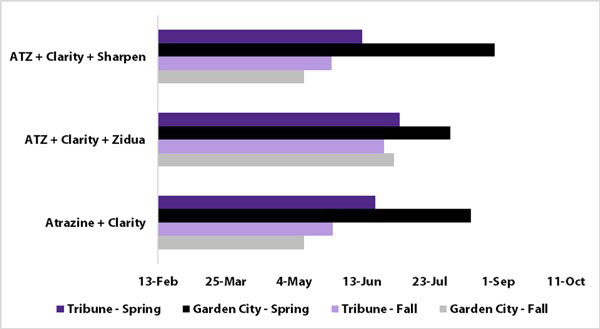Now is the time to finalize plans for kochia control. In western Kansas, kochia is among the first summer annual weed to emerge in the spring. Recent research suggests that kochia can begin emerging in early February, with most kochia emerging by late April. In fact, Pat Geier, Assistant Weed Scientist at the Southwest Research & Extension Center in Garden City, found kochia emerging in fallow plots during the first week of February.
Good control of the first dense flush of kochia is essential for obtaining a good yield. Early-emerging seedlings use the limited spring soil moisture in the dryland production area. Kochia seedlings emerge in dense populations, making adequate herbicide coverage difficult (Figure 1). In addition, glyphosate-resistant kochia is prevalent across western Kansas, making kochia control even more challenging. For these reasons, it is important to apply preemergence herbicides in late winter or early spring to control this weed before it emerges. This article will be the first in a series discussing specific options for various cropping scenarios.

Figure 1. Emerged kochia seedlings in a fallow field. Photo by Sarah Lancaster, K-State Research and Extension.
Herbicide program components to effectively manage kochia at germination
To successfully manage kochia, a herbicide program needs two components:
- a very soluble and effective herbicide that can be incorporated with very little precipitation, such as dicamba; and
- a herbicide that has longer residual activity, which will require perhaps 0.75 inches or more precipitation for adequate incorporation, such as atrazine.
Precipitation events during late winter are often too small to activate longer residual herbicides, but dicamba may control kochia for 4 to 6 weeks until the longer residual herbicide is incorporated.
The best time to apply herbicides for kochia control is generally January through the first week of March but prior to kochia emergence, which can vary depending on weather conditions. Later applications, for example, at the time of burndown, are more likely to occur after kochia emergence, which increases the risk of control failure (Figure 2). Fall-applied treatments can help ensure timely application; however, they are not likely to control later flushes of kochia effectively (Figure 3).

Figure 2. EPP/POST herbicides were applied on March 10, 2015, for kochia control at Tribune, KS. Kochia at cotyledon stage. Graph by C. Thompson, K-State Research and Extension.

Figure 3. Duration of anticipated kochia control greater than 80% following fall (December 4) and spring (February 23) herbicide applications at two locations during 2015. Data from V. Kumar, K-State Research and Extension.
Sarah Lancaster, Weed Management Specialist
slancaster@ksu.edu
Jeremie Kouame, Weed Scientist – Agricultural Research Center, Hays
jkouame@ksu.edu